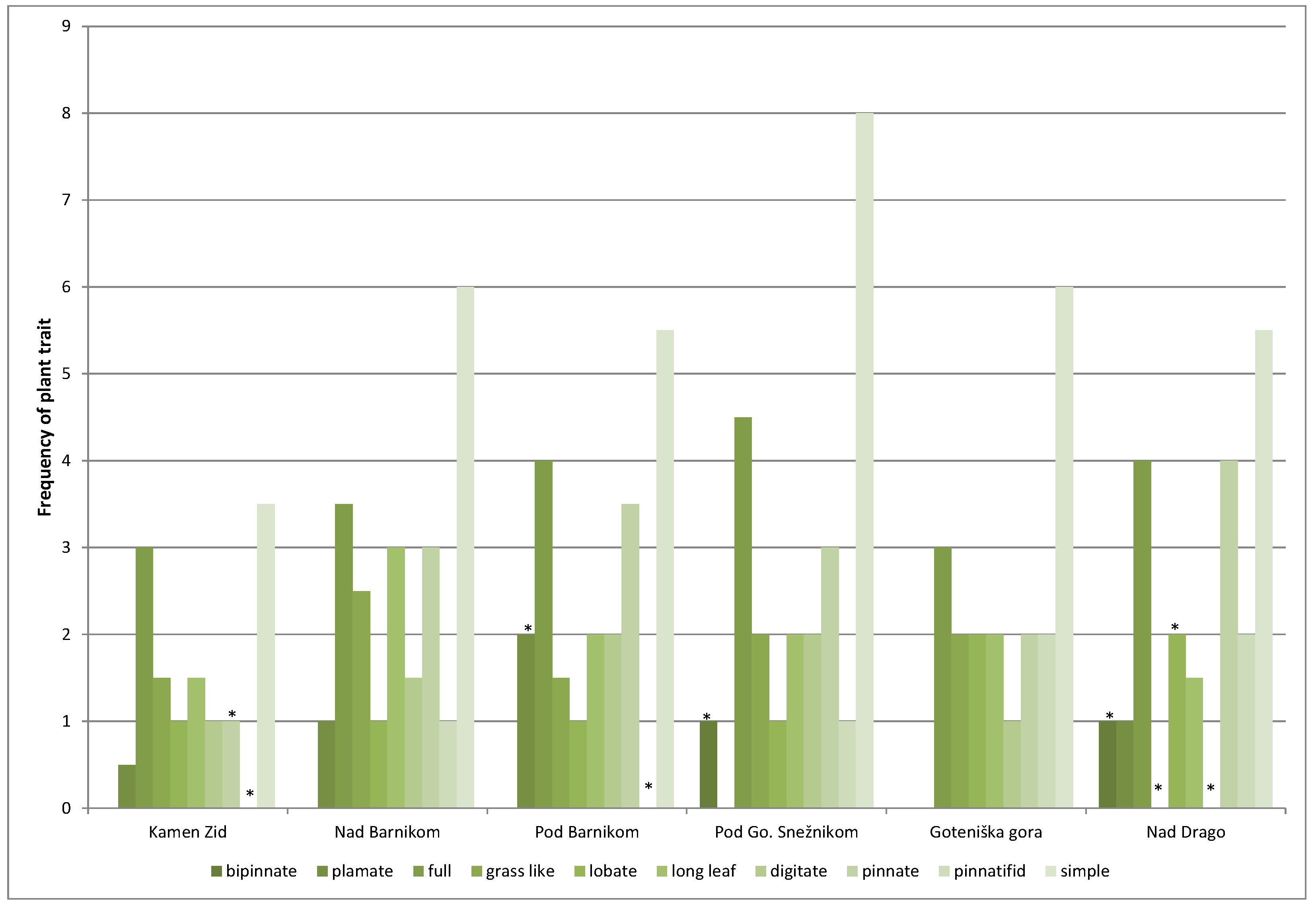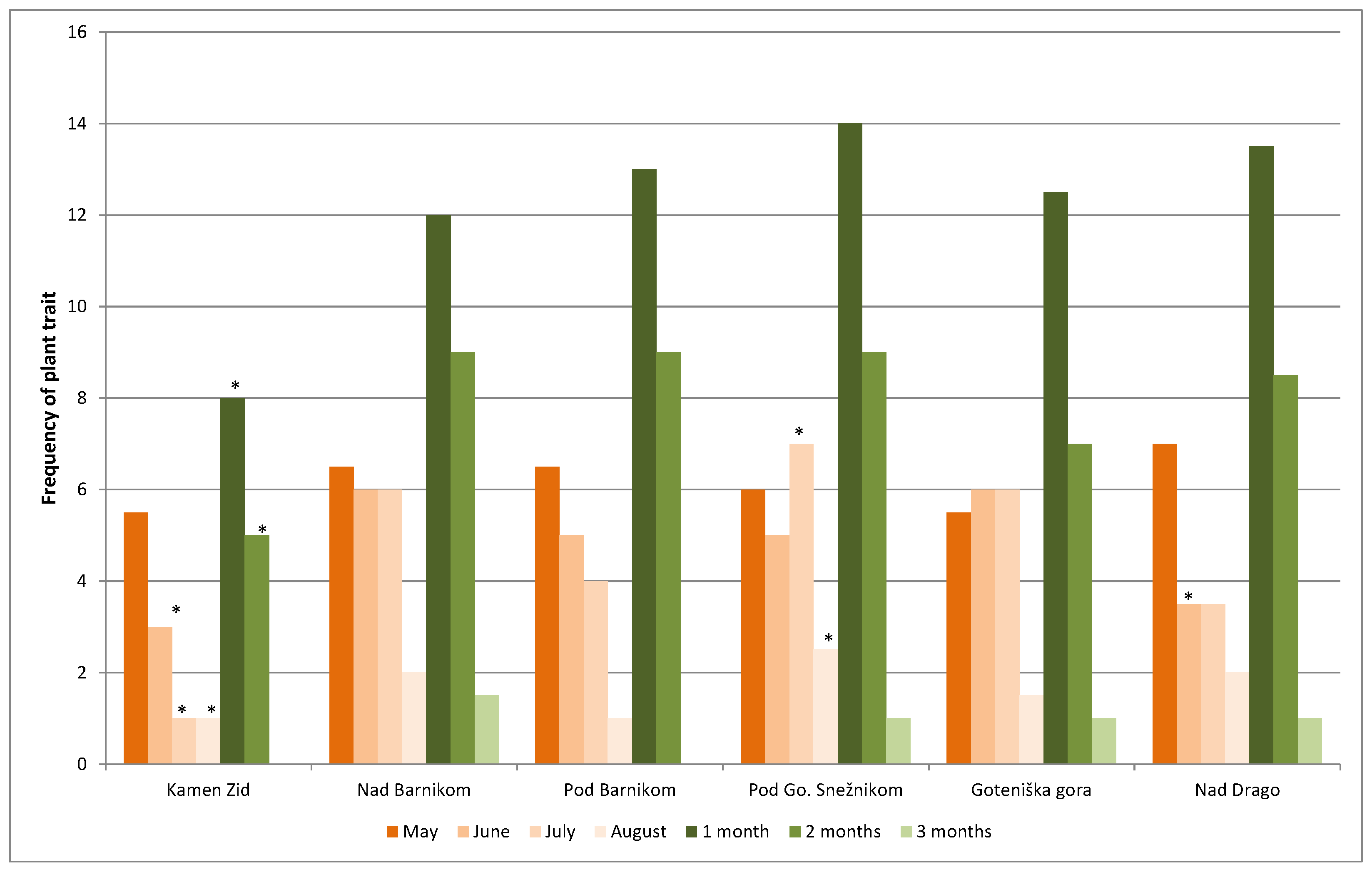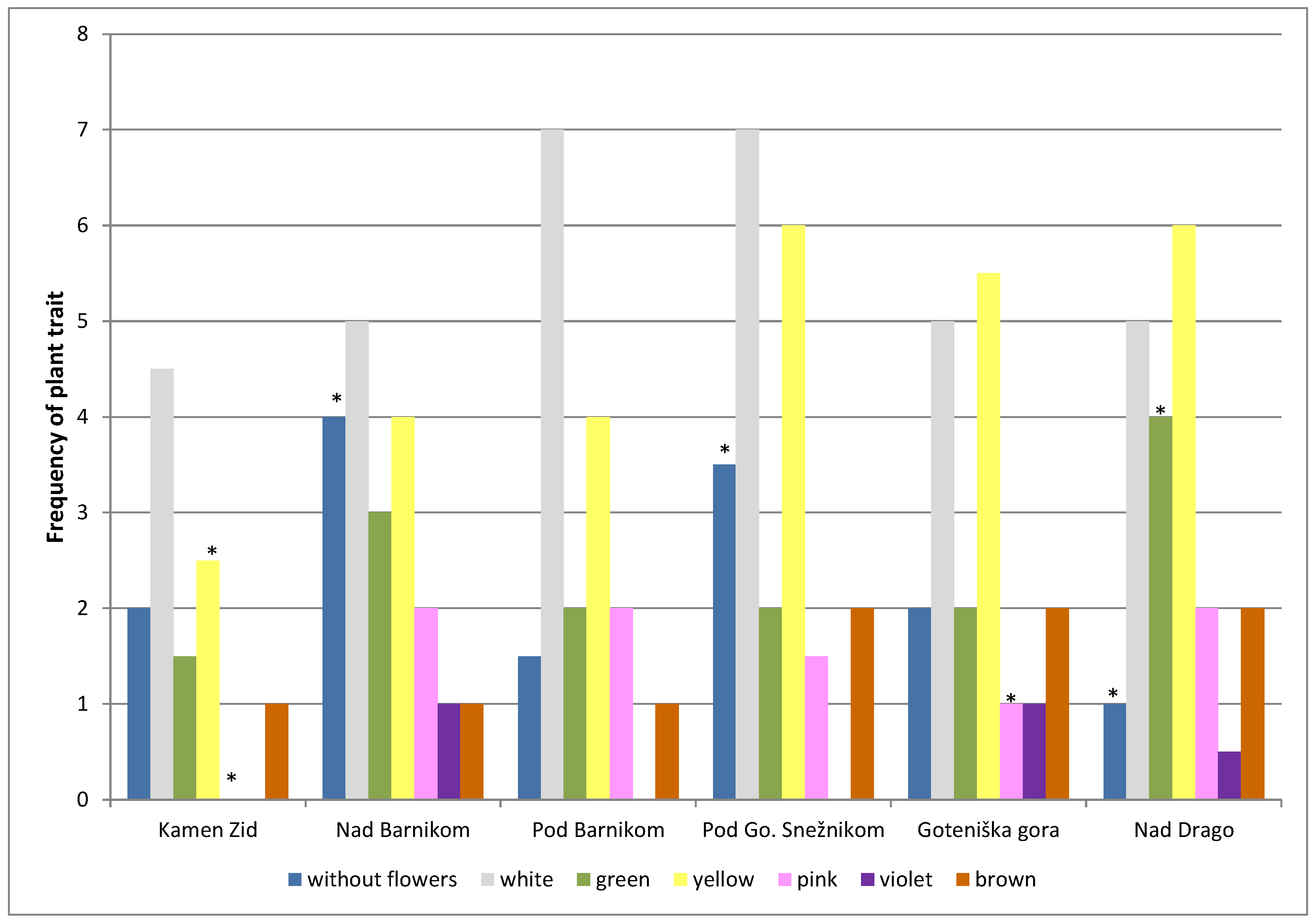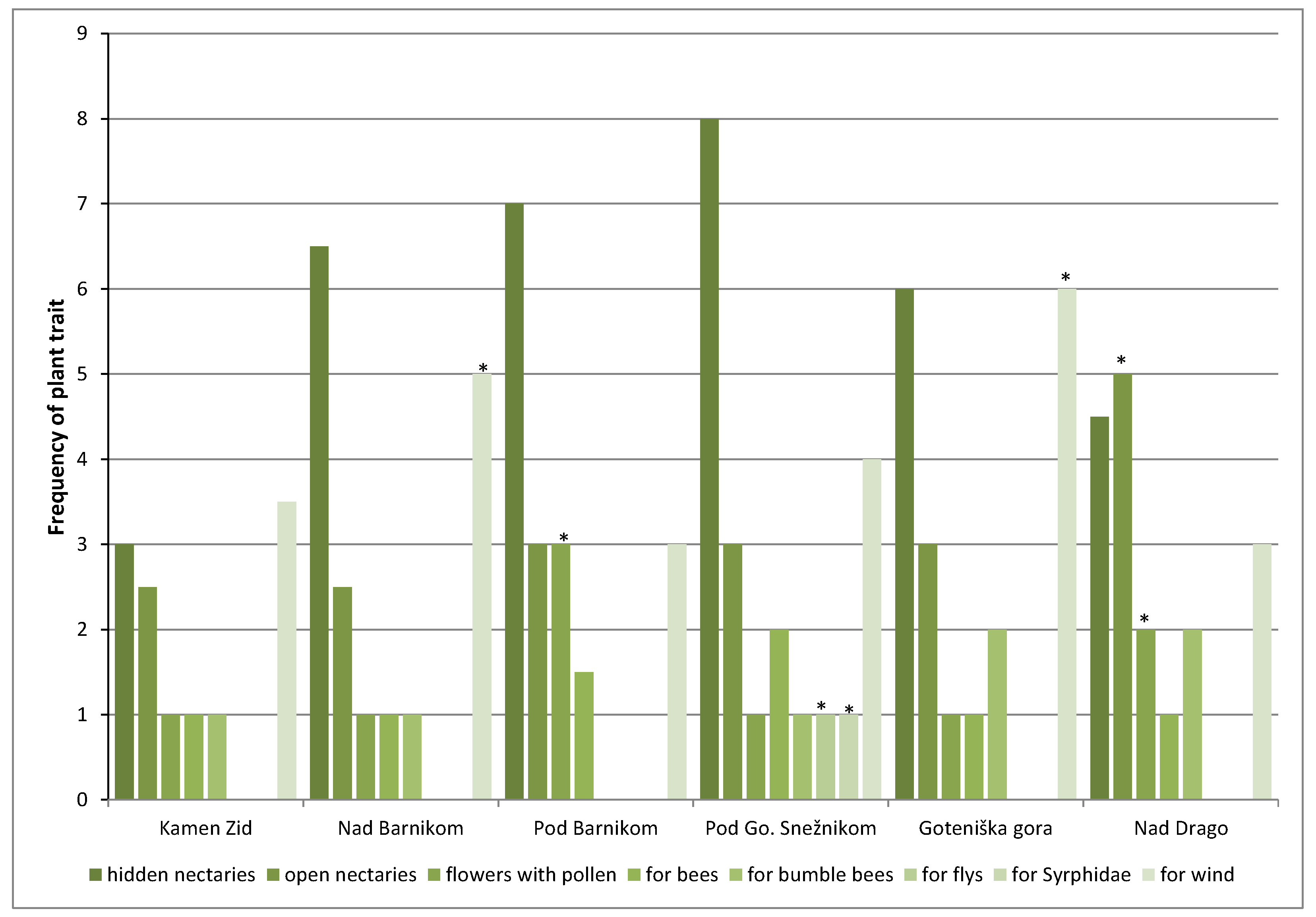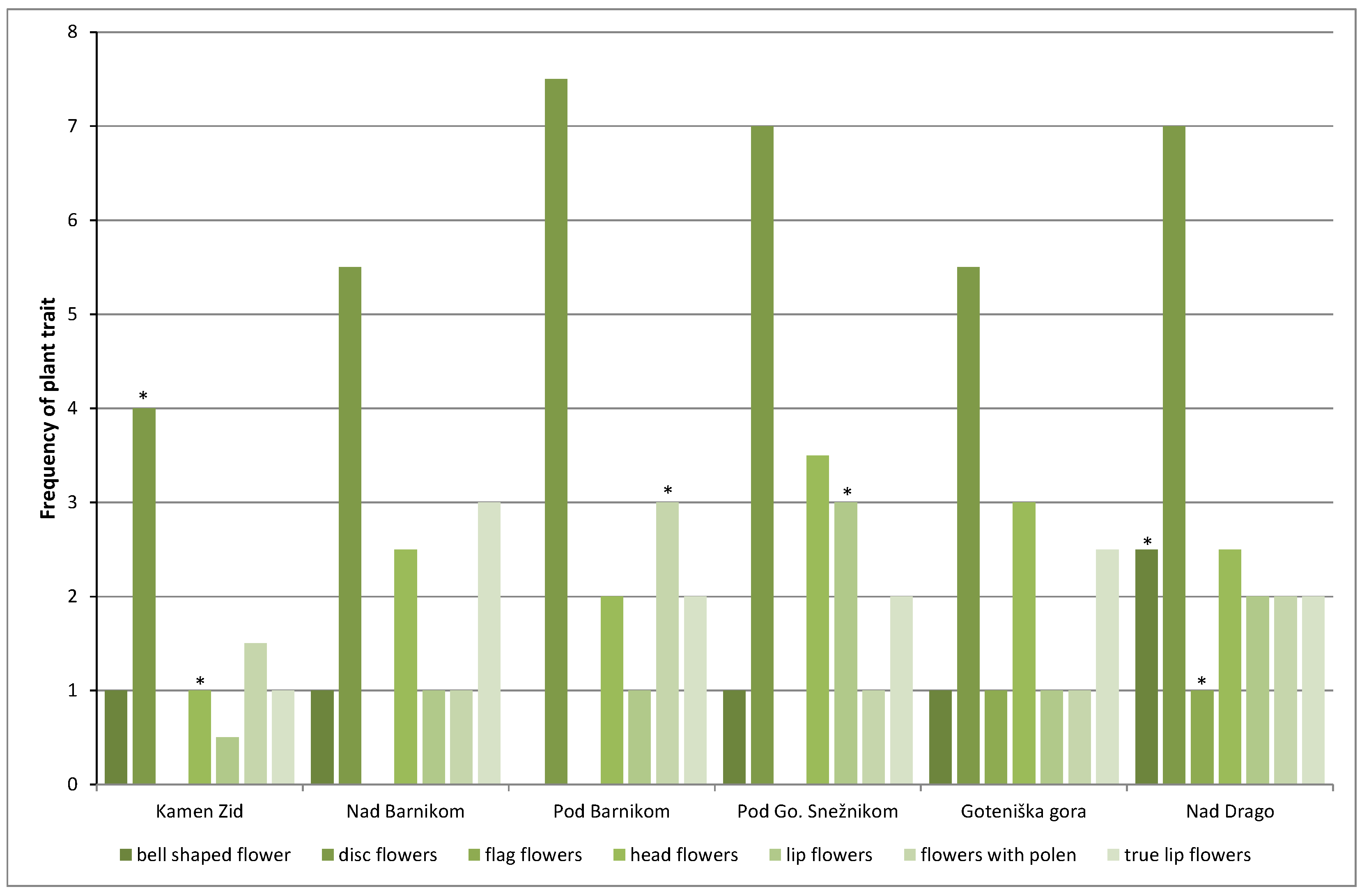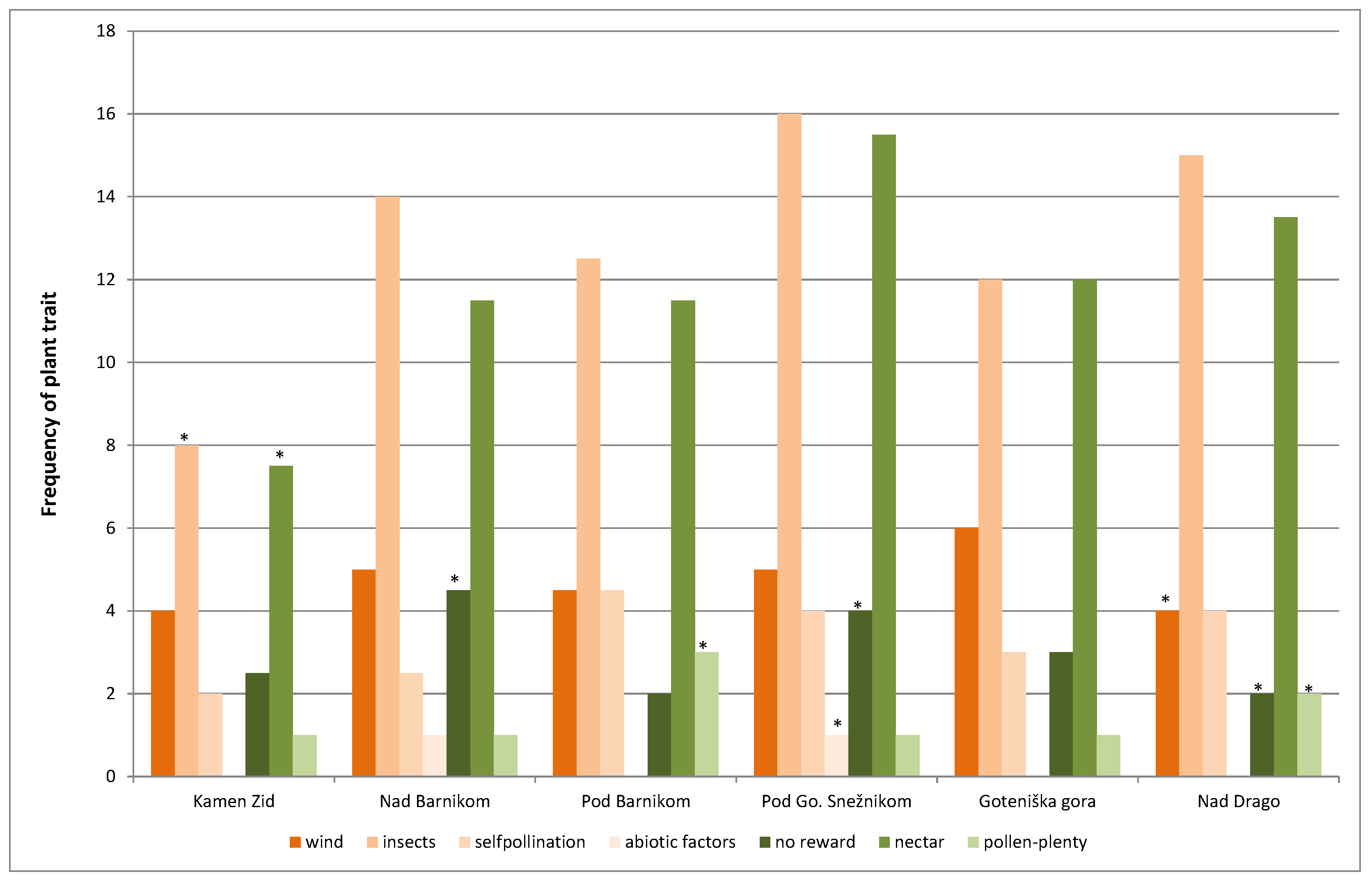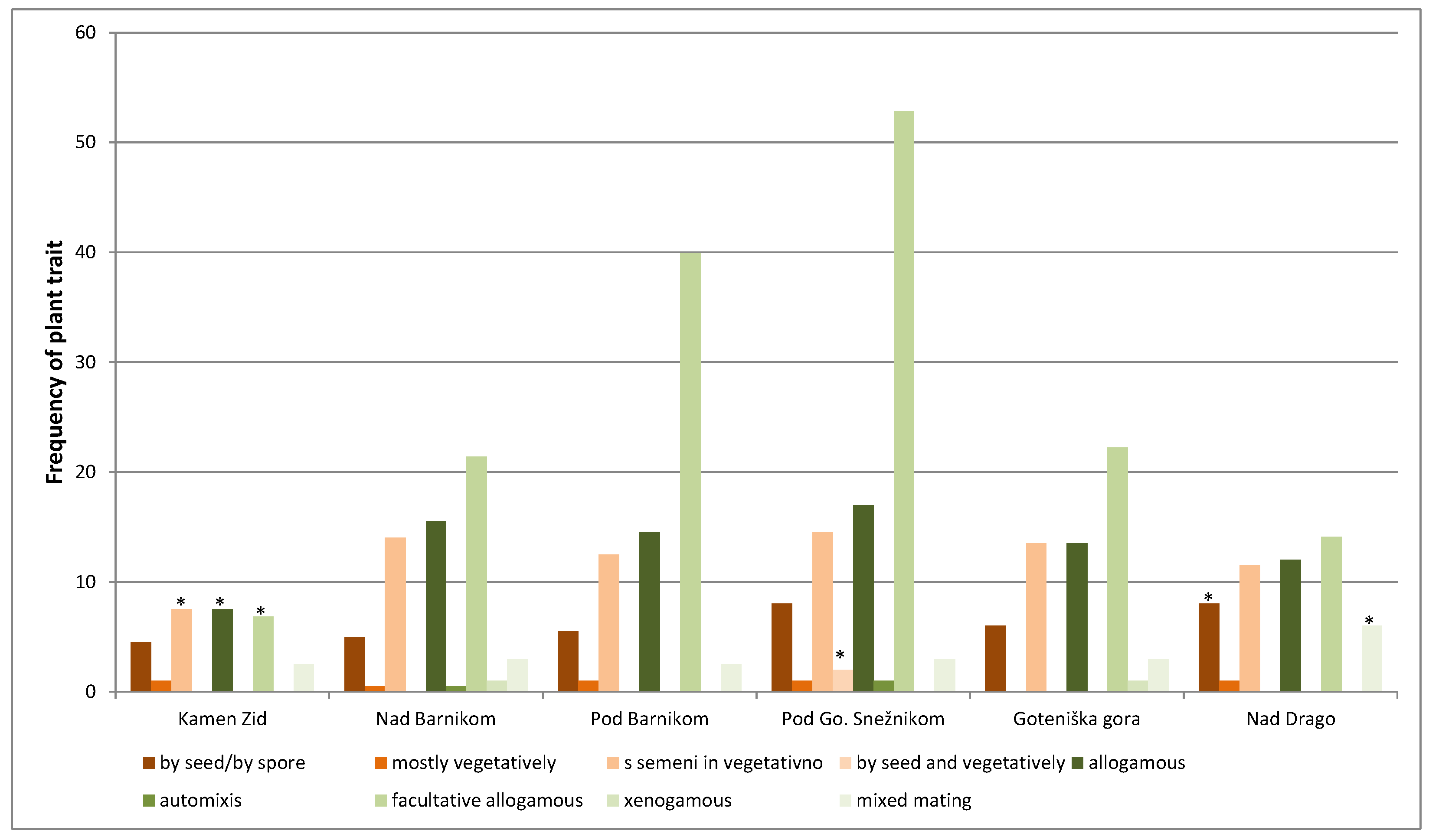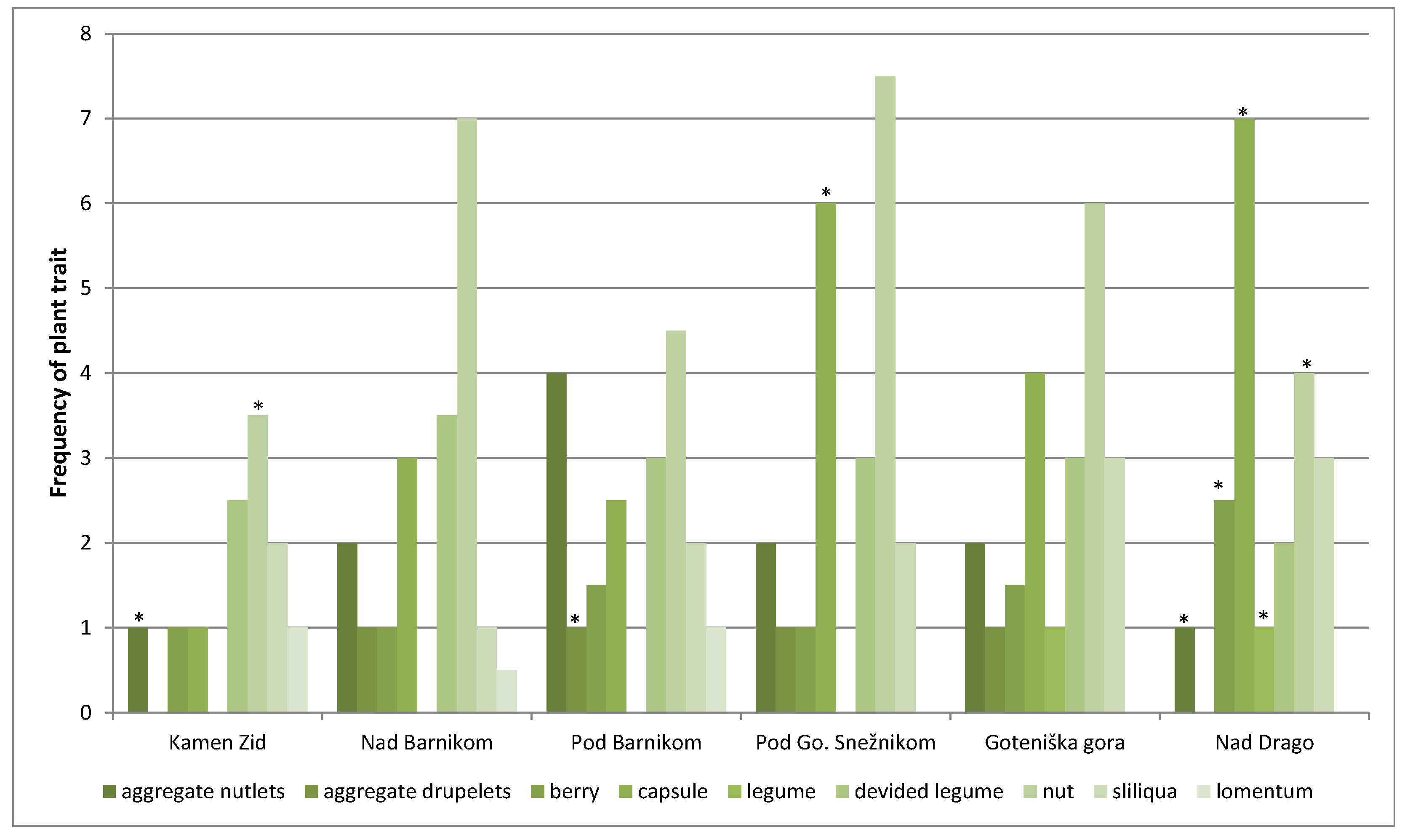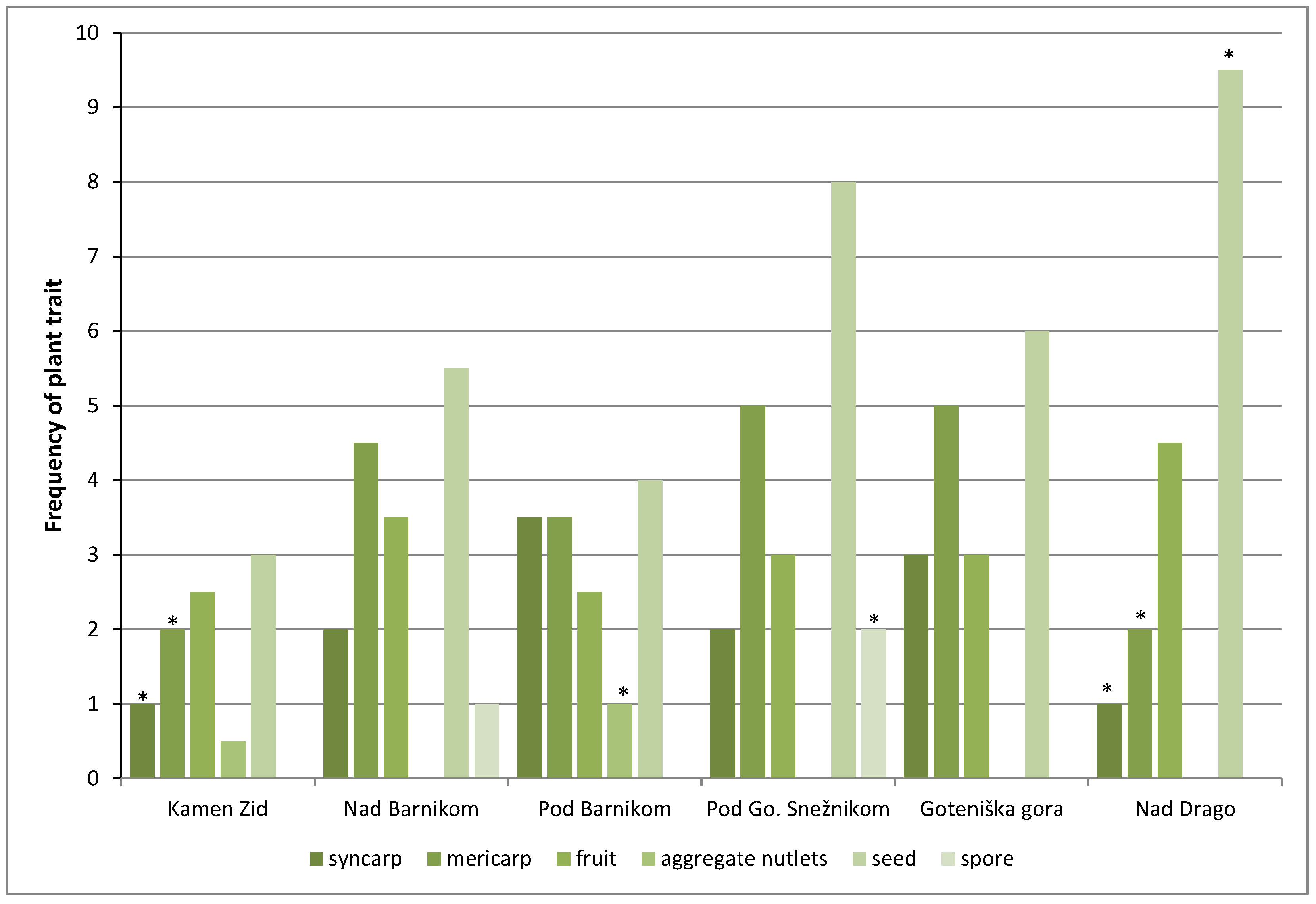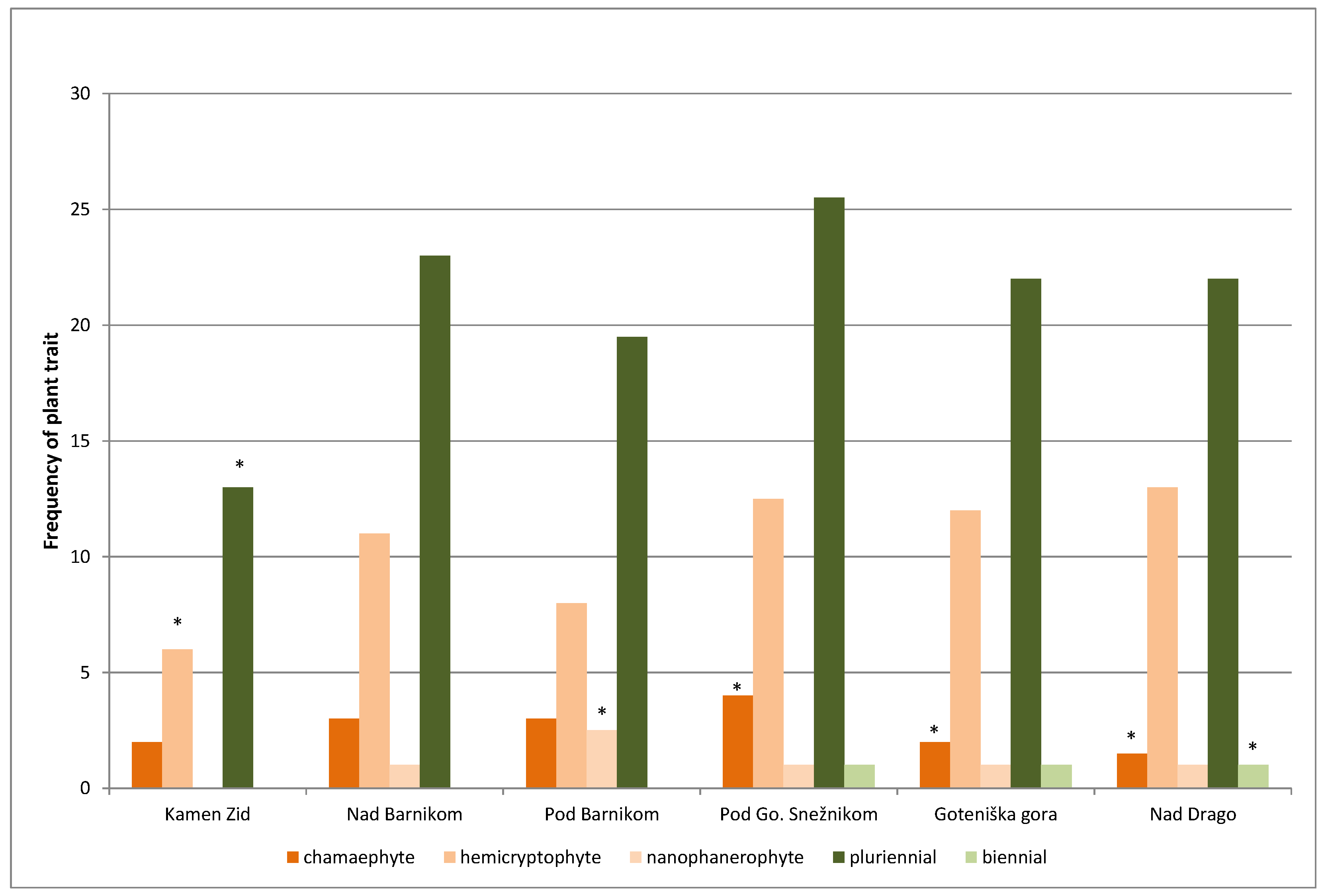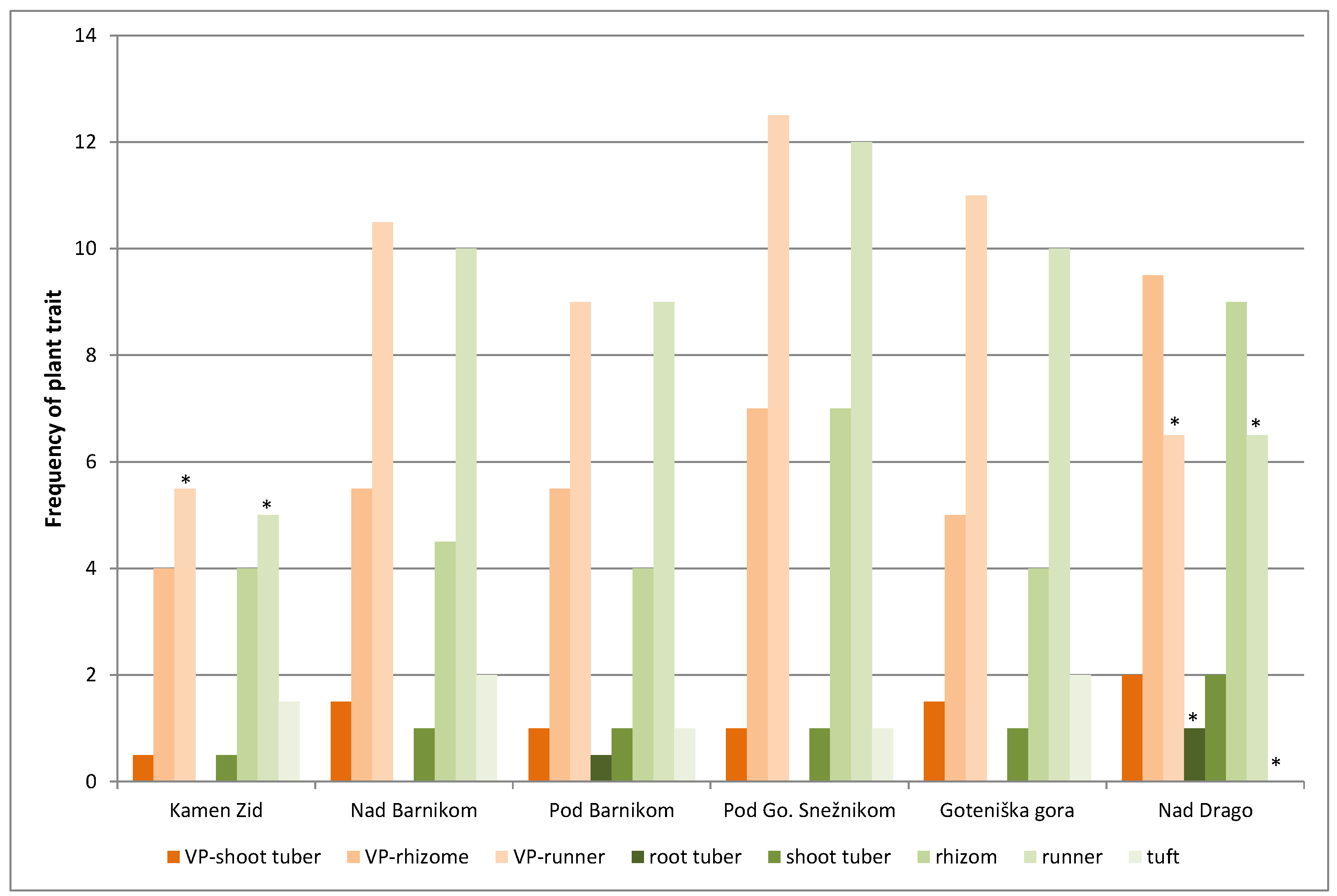1. Introduction
Plant species respond differently to environmental factors and the effects of ecosystem functioning. Their responses to environmental changes and contribution to ecosystem functions can be determined with the help of plant functional traits [
1]. According to the definition of Violle et al [
2], functional traits are any morphological, physiological or phenological characteristics at the individual level, from the cell to the whole organism without reference to the environment or any other level of organization. Plant functional traits describe interactions between individual plant specimens and between individual plant specimens and their environment [
3,
4]. This is why they can be an effective tool for studying the response of plant species to changes in the environment. Nowadays, they are mainly used to study the response of plant species to climate change, changes in land use either in agricultural landscapes or in more or less natural ecosystems and in natural processes of succession in the environment [
5,
6,
7,
8,
9]. Forest gaps are also subject to continuous succession, either as a result of natural disturbances or as a result of human activity. Basically, the forest dynamics are the same in all forest gaps and take place in the direction of overgrowth with tree species. However, the difference is in the speed of overgrowth and in the plant species composition. Due to the changes in biotic and abiotic factors from the forest gap emergence to the final successional stage, forest gaps can therefore represent sites for studying functional plant traits of plant species characteristic of the individual successional stage of forest gap. With the occurrence of forest gap, the illumination of the surface and the precipitation regime change, and temperature fluctuations are also greater. Forest gaps exposure to radiation depends largely on the size of the forest gap and the size of the trees in the surrounding forest stand. Namely, large trees shade the edges of the forest gap, and if it is small, they can shade it almost entirely. The amount of light that reaches the floor of the forest gap also depends on the latitude at which the forest gap is located, the slope of the terrain and the position on the adjacent or axial part. Both affect the angle of incidence of the sun's rays. The amount of incoming light also varies depending on the season and daily rhythm [
10,
11,
12]. At forest gap, the intensity of diffuse light decreases from the centre to the edges [
13]. The bigger the forest gap is, the more surface is exposed to light. The maximum light intensity in the forest gaps is reached between 10 a.m. and 2 p.m. and is greatest in the centre of the forest gap. Soil temperature has a positive correlation with light intensity, and in large forest gaps it increases from morning to evening. In small and medium forest gaps, soil temperature is highest between 12:00 and 14:00 [
12,
14]. As for humidity, compared to the forest, it is more exposed to light, as it is directly exposed to precipitation. In addition, the retaining capacity of the soil and bed rock has a great influence on it. Humidity is also higher in the centre and decreases towards the edges, where water is taken up from the soil by the roots of the surrounding trees [
12,
15,
16].
The newly formed forest gaps means a new living environment for both animals and plants. From the point of view of the flora, in the first phase after the formation of forest gap, the species composition of the forest gap depends on those tree species that stagnated in the undergrowth until the forest gap occurs and did not have enough light for growth, from the seed bank in the soil of the forest gap, and from the plant colonization of species from nearby and distant surroundings [
13]. The species that first colonize the forest gaps have a greater availability of resources than those that settle there later. Species heterogeneity is greater at bigger forest gaps [
17,
18]. Over time, when the herbaceous plants in the soil use up the available nutrients, their density begins to decrease and forest gaps begins to populate with shrub species as well. As the abundance of shrub species increases, the abundance of herbaceous species decreases and gradually the forest gap becomes overgrown with forest again [
19]. Constantly changing abiotic and biotic factors over the years on forest gap causes the species turn of. Some disappear or their coverage decreases, others increase [
20,
21].
In our research we analysed plant functional traits to research how they change according to the age of forest gap and thus to the individual successional stage. We were interested in which are the dominant plant functional traits of plants present at a certain age of forest gap. Given that we studied naturally occurring forest gaps, they were of different sizes, and therefore the forest gap size also represented a factor influencing the occurrence of plant species with individual plant functional traits. Knowing the occurrence of plant species with certain plant functional traits in a certain successional stage can help us understand the wider ecological meaning of forest gap in the forest ecosystem. Especially in the connection between plants and animals. Some plant functional traits are namely also vital for some animal species and their population dynamics [
22].
3. Results
Based on Spearman correlation coefficient (
Table 3), we found that only hamephytes are statistically strongly correlated with forest gaps. Furthermore, perennials and herbaceous perennials are characteristic for forest gaps. In terms of plant morphology, there is a statistically significant positive correlation between forest gaps and plant species whose storage organs are stolons in the case of "runners" and cluster roots and with summer-green, mesomorphic leaves (intermediate stage between scleromorphic and hydromorphic leaves). Species that have palmately lobed, linear or simple leaves are also characteristic. There is a typical positive correlation between forest gaps and plant species with red and white labiate flowers with have hidden nectaries and pollinated mainly by bees, flies, and especially by hover flies. Pollinators are primarily attracted by the nectar, but there is a significant positive correlation with plant species without any 'reward' in the flower. Species without flowers (ferns) are also positively correlated with forest gaps. A statistically significant positive correlation with forest gaps was shown for species that begin flowering in June and July and species that flower for two or three months. In terms of reproduction, there is a positive correlation between forest gaps and species that can reproduce simultaneously by seeds and vegetatively or simultaneously by spores and vegetatively, and whose pollen vector is wind and abiotic factors. These species are also allogamic, facultatively allogamic or characterised by automixis. Species that spread with stone fruits or clusters of stone fruits, aggregate fruits and loments are characteristic for the surveyed forest gaps. In this regard, there was a significant positive correlation of species whose unit of seed dispersal is represented by a fruit with an appendage and a cluster of fruits.
There is a statistically significant negative correlation between forest gaps and plant species that are biennial and store nutrients in the primary storage root and in the tubers in the case of runners. There is also a negative correlation with species with lobed leaves and green-coloured, bell-shaped or papilionaceous flowers with open nectaries, pollen or traps. Furthermore, a negative correlation was also found for species who begin flowering in May and for species pollinated by bumblebees. In terms of dissemination, however, there was a negative correlation between forest gaps and species with berries and legumes.
Individual locations differed statistically in 87 categories of plant functional traits. In terms of life forms of plant species and their life cycle, the location Kamen zid differed the most, with statistically significant lowest presence of hemicryptophytes and statistically significant lowest presence of perennials in the undergrowth. The location Pod Barnikom also differed from others, as it had the highest presence of nanerophytes compared to the other five locations. Of the five locations, the location Pod Goteniškim Snežnikom differed because of the highest presence of hamephytes, while the locations Goteniška gora and Nad Drago differed from the other three in terms of the presence of hamephytes. The location Nad Drago differed statistically from the other three locations because of the presence of biennial plants. There were no biennial plants at the locations Kamen zid, Nad Barnikom and Pod Barnikom (
Figure 1).
In terms of type of vegetative reproduction, the locations Kamen zid and Nad Drago statistically differed the most from the other locations (
Figure 2). Compared to other locations, these locations had the lowest number of plant species that reproduce with stolons. The same applies to the method of storing energy. Both locations had the fewest species that store their energy in the creeping parts of the plant. Additionally, the forest gap Nad Drago differed from three locations because of the highest presence of species that store their energy in the primary storage root and the fact that it had no plant species that store their energy in the cluster roots, unlike in other locations.
In terms of leaf anatomy and leaf persistence, the location Kamen zid differed yet again (
Figure 3). Specifically, compared to the other five locations, the location Kamen zid had statistically significant lowest number of species with mesomorphic leaves and summer green leaves, and compared to three other locations (Nad Barnikom, Pod Goteniškim Snežnikom, Nad Drago), it had the lowest number of species with scleromorphic and evergreen leaves (compared to Goteniški Snežnik, Goteniška gora and Nad Drago). In terms of leaf form, the location Nad Drago stood out, differing statistically from the other locations in that we did not find any species with linear or palmately lobed leaves. The most common species were those with lobed leaves. Together with the location Pod Goteniškim Snežnikom, they differed from the other locations in that they were the only two locations with plant species with bipinnate leaves. The locations Kamen zid and Pod Barnikom stood out from the other three locations with the lowest presence of species with pinnate leaves. The location Kamen zid also had statistically significant differences from three locations (Nad Barnikom, Pod Barnikom, Nad Drago), as it had the lowest presence of species with pinnate leaves. Compared to the other four locations (except for Nad Drago), the location Pod Barnikom had the lowest occurrence of species with palmately compound leaves.
We also observed statistically significant differences between locations in terms of the beginning of flowering and flowering duration. Once again, the location Kamen zid differed the most from the other locations, as it had the lowest occurrence of species that start flowering in June, July or August (
Figure 4). Furthermore, it also had the fewest species that flower for one or two months. While the location Pod Goteniškim Snežnikom differed from the four other locations in that it had the highest presence of plant species that begin flowering in July, the same location also differed from three other in that it had a lower presence of species flowering in August. The location Nad Drago, like the location Kamen zid, also differed from the same three locations because it had a lower presence of species that begin flowering in June. We also observed statistically significant differences between locations in the presence of plant species with a specific flower colour. The most species without flowers were present at the locations Nad Barnikom and Pod Goteniškim Snežnikom, while the location Nad Drago had the fewest species. The location Kamen zid had the fewest plant species with yellow and pink flowers. There were also significantly less of the latter at the location Goteniška gora. The most species with green flowers were at the location Nad Drago (
Figure 5).
Figure 4.
Mediana of frequencies of plant species with individual plant functional traits category leaf form is represented. Statistical diferences with Bonferroni test between individual localities were calculated. With star are marked those categories, in which single location is statisticaly significat different from at least three others.
Figure 4.
Mediana of frequencies of plant species with individual plant functional traits category leaf form is represented. Statistical diferences with Bonferroni test between individual localities were calculated. With star are marked those categories, in which single location is statisticaly significat different from at least three others.
Figure 5.
Mediana of frequencies of plant species with individual plant functional traits categories beginning of flowering and flowering duration are represented. Statistical diferences with Bonferroni test between individual localities were calculated. With star are marked those categories, in which single location is statisticaly significat different from at least three others.
Figure 5.
Mediana of frequencies of plant species with individual plant functional traits categories beginning of flowering and flowering duration are represented. Statistical diferences with Bonferroni test between individual localities were calculated. With star are marked those categories, in which single location is statisticaly significat different from at least three others.
Figure 6.
Mediana of frequencies of plant species with individual plant functional traits category flower colour is represented. Statistical diferences with Bonferroni test between individual localities were calculated. With star are marked those categories, in which single location is statisticaly significat different from at least three others.
Figure 6.
Mediana of frequencies of plant species with individual plant functional traits category flower colour is represented. Statistical diferences with Bonferroni test between individual localities were calculated. With star are marked those categories, in which single location is statisticaly significat different from at least three others.
The location Pod Goteniškim Snežnikom had statistically significant differences in terms of the flower type after Müller (
Figure 7). This locations had the lowest occurrence of plant species pollinated by various types of wasps and flies. The statistically significant highest number of plant species whose flowers contain primarily pollen was at the location Pod Barnikom, and the lowest at the location Nad Drago. The latter locations also stood out with the highest occurrence of species with exposed nectaries in the flower. The statistically significant highest number of wind-pollinated plant was at the locations Nad Barnikom and Goteniška gora. The analysis of the flower form after Kugler also showed a statistically significant highest number of plant species with flowers rich in pollen at the location Pod Barnikom. In terms of representation of other categories, the location Kamen zid stood out again with the lowest occurrence of plant species with bowl-shaped flowers or capitula. While the location Pod Goteniškim Snežnikom had the most species with labiate flowers, the locations Goteniška gora and Nad Drago had the most species with papilionaceous flowers. Additionally, the location Nad Drago had the statistically significant highest presence of bell-shaped flower species (
Figure 8). The location Nad Drago location also differed in most categories in terms of flower award and pollen vector. Compared to three other locations (Nad Barnikom, Pod Goteniškim Snežnikom, Goteniška gora), it had fewer species whose pollen vector is wind and whose flowers have no award for pollinators. The locations Nad Barnikom and Pod Goteniškim Snežnikom differed from the others in terms of the greatest presence of species without a flower award, with the latter also differing from the four other locations by the greater presence of species that have the ability to self-pollinate. The location Kamen zid differed from the others with the lowest presence of species whose pollen is transferred by insects and species whose method of attracting pollinators is the nectar in the flower (
Figure 9).
Figure 7.
Mediana of frequencies of plant species with individual plant functional traits category flower type after Müller is represented. Statistical diferences with Bonferroni test between individual localities were calculated. With star are marked those categories, in which single location is statisticaly significat different from at least three others.
Figure 7.
Mediana of frequencies of plant species with individual plant functional traits category flower type after Müller is represented. Statistical diferences with Bonferroni test between individual localities were calculated. With star are marked those categories, in which single location is statisticaly significat different from at least three others.
Figure 8.
Mediana of frequencies of plant species with individual plant functional traits category flower type after Kugler is represented. Statistical diferences with Bonferroni test between individual localities were calculated. With star are marked those categories, in which single location is statisticaly significat different from at least three others.
Figure 8.
Mediana of frequencies of plant species with individual plant functional traits category flower type after Kugler is represented. Statistical diferences with Bonferroni test between individual localities were calculated. With star are marked those categories, in which single location is statisticaly significat different from at least three others.
Figure 9.
Mediana of frequencies of plant species with individual plant functional traits categories flower award and pollen vector are represented. Statistical diferences with Bonferroni test between individual localities were calculated. With star are marked those categories, in which single location is statisticaly significat different from at least three others.
Figure 9.
Mediana of frequencies of plant species with individual plant functional traits categories flower award and pollen vector are represented. Statistical diferences with Bonferroni test between individual localities were calculated. With star are marked those categories, in which single location is statisticaly significat different from at least three others.
Figure 10.
Mediana of frequencies of plant species with individual plant functional traits categories type of reproduction and type of breeding system are represented. Statistical diferences with Bonferroni test between individual localities were calculated. With star are marked those categories, in which single location is statisticaly significat different from at least three others.
Figure 10.
Mediana of frequencies of plant species with individual plant functional traits categories type of reproduction and type of breeding system are represented. Statistical diferences with Bonferroni test between individual localities were calculated. With star are marked those categories, in which single location is statisticaly significat different from at least three others.
Figure 11.
Mediana of frequencies of plant species with individual plant functional traits category fruit type is represented. Statistical diferences with Bonferroni test between individual localities were calculated. With star are marked those categories, in which single location is statisticaly significat different from at least three others.
Figure 11.
Mediana of frequencies of plant species with individual plant functional traits category fruit type is represented. Statistical diferences with Bonferroni test between individual localities were calculated. With star are marked those categories, in which single location is statisticaly significat different from at least three others.
Figure 12.
Mediana of frequencies of plant species with individual plant functional traits category diaspore type is represented. Statistical diferences with Bonferroni test between individual localities were calculated. With star are marked those categories, in which single location is statisticaly significat different from at least three others.
Figure 12.
Mediana of frequencies of plant species with individual plant functional traits category diaspore type is represented. Statistical diferences with Bonferroni test between individual localities were calculated. With star are marked those categories, in which single location is statisticaly significat different from at least three others.
4. Discussion
According to the analysis of plant functional traits in the comparison of forest gaps, the forest gap Nad Drago showed the largest deviations amongst all locations. Its deviation can be explained by the fact that this forest gap is the youngest and represents the beginning of the succession. As a newly exposed area, it represents a settlement area for pioneer plant species, most of which are biennials. Moore and Vankat [
32] reached similar conclusions, except that they found a higher percentage of annual plants for one- or two-year-old forest gaps. On older forest gaps, their percentage was minimal, as was in our study. The statistically significant higher percentage of species with roots as the primary storage organ can be explained by the fact that there are still many early spring species of forest understorey in the forest gap Nad Drago, whose rapid growth in spring is facilitated by the energy stored in the root [
33,
34]. It should be noted that the forest understorey was better developed in the nearby old-growth stage beech forest than that in the juvenile phase beech forest. In an old-growth stage forest, more light reaches the ground than in a juvenile stage forest. The presence of early spring plants is also indicated by the analysis of flowering, showing the statistically significant lowest number of plants flowering in summer compared to other forest gaps. A comparison within the forest gaps showed that most species on the forest gap flower in May. However, we should not forget that all studied forest gaps are located in an area that can still be under a cover of snow in April. In terms of flowering, there should be the fewest species without flowers in this forest gap. The result is because of the fact that the BiolFlor database lists grasses and sedges, in addition to ferns, as non-flowering plants. It is also true that the coverage of grasses and sedges was the lowest at the location Nad Drago. Considering that we observed the occurrence of species such as
B. sylvaticum in larger populations during our study, primarily in forest gaps and not in the forest, we can conclude that overgrowth with grasses has not yet started, as the forest gap is the youngest. Among other flowering species, there was a statistically higher occurrence of species with bell-shaped flowers at this location compared to others. A statistically significant higher occurrence of species with exposed nectaries is also correlated to this flower form. Bell-shaped flowers and exposed nectaries define simpler flowers, in which nectar is more easily accessible and thus available to different pollinators [
35]. In this location, we also found statistically more plant species with green flowers. Considering that green-coloured flowers are predominantly pollinated by hover flies and that there was no statistically significant correlation with other types of pollinators, the higher occurrence of bell-shaped flowers and flowers with exposed nectaries is more likely the result of the species composition in the forest gap. The same could explain the result that, there are the location Nad Drago has the statistically highest number of species that are simultaneously allogamous and autogamous, compared to other species. Several species with this trait were found only in this location. Although this location has the highest number of species that reproduce by seeds and spores, when viewed as a whole, reproduction by seeds and vegetatively still prevails on this forest gap (as does on other forest gaps).
According to some statistically significant differences between plant functional traits, the forest gap Pod Barnikom is somewhat similar to the juvenile stage beech forest at the location Kamen zid. It has the same statistically significant lower number of plant species with pinnate and palmately lobed leaves as on the other forest gaps. As already mentioned, plants with lobed leaves are characteristic of more open and wind-exposed areas [
36], and the mentioned forest gap is less exposed to wind because it is the smallest and shaded and protected from the sides by tall trees. As a result, it has fewer plant species with a leaf form that is adapted to efficiently bear mechanical pressures [
36]. In fact, smaller, long and narrow forest gaps have less influence on the understorey [
17,
18]. The characteristic of overgrowing forest gap is the result of the statistically significant higher presence of nanophanerophytes. However, we should emphasise the influence of its size on the results. As it is the smallest, the percentage of overgrowing surface is greater than that of the other forest gaps, although there is already noticeable overgrowing at the edges of other forest gaps; however, because of their sizes, it will take longer for other forest gaps to become overgrown compared to the forest gap Pod Barnikom. Here, again compared to the other forest gaps, there was a statistically significantly higher number of plant species that predominantly provide pollinators with pollen. However, this is probably primarily because of the species composition, since species with hidden nectaries still dominate, like on all other forest gaps. The same could be said for the statistical differences between locations in terms of fruit type and diaspore type. However, at the location Nad Barnikom, most statistically significant differences that separate the forest gaps from all others are the result of the greater coverage of grasses and sedges on this forest gap. Specifically, grasses are pollinated by wind, are defined in the BiolFlor database as plants without flowers, and considering they are pollinated by wind, they also represent the percentage of plant species that do not provide a pollinator with an award in the flower. Statistically significant differences in plant functional traits therefore define the forest gap Nad Barnikom as a forest gap with more grasses and sedges compared to the other forest gaps.
According to the analysis of plant functional traits, the forest gap Goteniška gora differed the least from the other forest gaps. It had a statistically significant higher number of anemophilous plants than other forest gaps, but this was again caused by the representation of grasses. Statistically significant differences in flower colour and form are probably only the result of species composition and do not represent a specific characteristic of the forest gap. With the help of plant functional traits, we can recognise the specific characteristic of the forest gap Pod Goteniškim Snežnikom. The statistically significant higher presence of plant species that are without flowers, without a flower award for the pollinator, and are reproducing simultaneously with spores and vegetatively, indicates a higher proportion of ferns compared to the other forest gaps. Ferns prefer humid areas, with the aforementioned forest gap having the highest Ellenberg's humidity value of all forest gaps. It also differs from other forest gaps by the higher presence of plant species flowering in July. The reason for this difference could be its altitude. It is the highest lying forest gap of all studied forest gaps, as a result of which the growing season starts later and most species flower in July. Differences in other functional traits are also probably the result of species composition.
